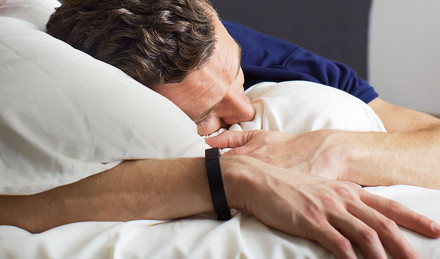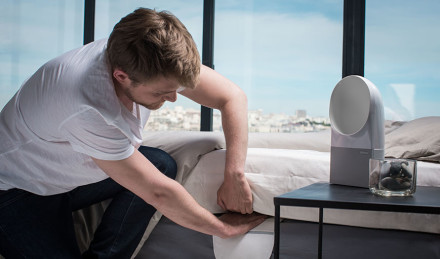Sleep tracking is an intriguing idea: By monitoring your sleep cycles, you can come to better understand what you, personally, require to get a solid night’s rest. Sounds great – who doesn’t want that? But how exactly can an app on your phone or a fitness tracker monitor your sleep? We break it down…

The Different Kinds of Sleep Monitors
Sleep tracking devices — whether an app on your phone, a wearable fitness tracker or a dedicated sleep monitor – look at your sleep-wake cycles to determine the quality of your sleep on a given night. The thinking is that by cross-referencing your sleep data with other factors like your diet, exercise patterns or alcohol and caffeine consumption – as well as just your general mood (asking yourself, “Do I feel rested?” in the morning) – you can notice patterns and optimize how you sleep. There are three main types of sleep monitors: Standalone smartphone apps, wearables (including fitness trackers like the Jawbone Up or a FitBit) and dedicated devices.
Smartphone apps and wearables rely mostly on movement tracking through the device’s accelerometer (an internal component that detects motion) to determine what sleep stage you’re in and for how long. A standalone app will tell you to sleep with the phone on your mattress so it can detect movement when you toss and turn, while a wearable fitness tracker’s app will get the data straight from the device on your body.
Dedicated sleep devices – which include things like bed-side monitors that use sensors aimed at your bed or a thin pad that you lay on top of your mattress – also track motion, as well as other variables like room temperature, brightness, breathing patterns and more. Many of these devices, including smart phone apps, also detect sound levels so you can correlate any wakefulness with noise.
The Different Kinds of Sleep Monitors
Sleep tracking devices — whether an app on your phone, a wearable fitness tracker or a dedicated sleep monitor – look at your sleep-wake cycles to determine the quality of your sleep on a given night. The thinking is that by cross-referencing your sleep data with other factors like your diet, exercise patterns or alcohol and caffeine consumption – as well as just your general mood (asking yourself, “Do I feel rested?” in the morning) – you can notice patterns and optimize how you sleep. There are three main types of sleep monitors: Standalone smartphone apps, wearables (including fitness trackers like the Jawbone Up or a FitBit) and dedicated devices.
Smartphone apps and wearables rely mostly on movement tracking through the device’s accelerometer (an internal component that detects motion) to determine what sleep stage you’re in and for how long. A standalone app will tell you to sleep with the phone on your mattress so it can detect movement when you toss and turn, while a wearable fitness tracker’s app will get the data straight from the device on your body.
Dedicated sleep devices – which include things like bed-side monitors that use sensors aimed at your bed or a thin pad that you lay on top of your mattress – also track motion, as well as other variables like room temperature, brightness, breathing patterns and more. Many of these devices, including smart phone apps, also detect sound levels so you can correlate any wakefulness with noise.

But Does Using Motion to Measure Sleep Work?
If you were to go to a lab to have your sleep monitored, they’d use a method called polysomnography, which tracks several variables including brain function, eye movement, muscle activity and heart rhythm.
Another, less invasive method that can be done at home is called actigraphy. Actigraphy simplifies sleep measurement down to one variable: Movement. Basically, you wear a small device that tracks how you move in your sleep. (Researchers like actigraphic studies because they allows the subjects to remain at home, in their normal sleep setting, therefore possibly giving more organic results).
This is exactly what your smartphone or fitness tracker is doing (though most likely in a much less sophisticated way). These devices then analyze your movement to determine how much light, REM and deep sleep you get in a night.
But Does Using Motion to Measure Sleep Work?
If you were to go to a lab to have your sleep monitored, they’d use a method called polysomnography, which tracks several variables including brain function, eye movement, muscle activity and heart rhythm.
Another, less invasive method that can be done at home is called actigraphy. Actigraphy simplifies sleep measurement down to one variable: Movement. Basically, you wear a small device that tracks how you move in your sleep. (Researchers like actigraphic studies because they allows the subjects to remain at home, in their normal sleep setting, therefore possibly giving more organic results).
This is exactly what your smartphone or fitness tracker is doing (though most likely in a much less sophisticated way). These devices then analyze your movement to determine how much light, REM and deep sleep you get in a night.

Can They Be Trusted?
Here’s the thing about sleep trackers: Their value is that they provide visibility into patterns that you might not have noticed before — then it’s up to you to understand how to use this information to help try and get a better night’s sleep. And because many of these apps also incorporate diet and exercise tracking, it can be easier to see these correlations.
For example, most people get less REM sleep and wake up earlier when they’ve been drinking alcohol – sometimes even just a couple glasses of wine. Others might find that a day without exercise means less deep sleep and therefore a struggle to throw off the duvet in the morning. And still others might just notice that it’s not about eight hours of sleep to feel well-rested, but a certain combination of deep and REM sleep.
Can They Be Trusted?
Here’s the thing about sleep trackers: Their value is that they provide visibility into patterns that you might not have noticed before — then it’s up to you to understand how to use this information to help try and get a better night’s sleep. And because many of these apps also incorporate diet and exercise tracking, it can be easier to see these correlations.
For example, most people get less REM sleep and wake up earlier when they’ve been drinking alcohol – sometimes even just a couple glasses of wine. Others might find that a day without exercise means less deep sleep and therefore a struggle to throw off the duvet in the morning. And still others might just notice that it’s not about eight hours of sleep to feel well-rested, but a certain combination of deep and REM sleep.
So Which Ones Work Best?
The internet is full of first-person tests pitting a variety of trackers against each other and testing for accuracy. There are almost always — and not surprisingly — discrepancies. And since most of these devices are based on the same actigraphic methods, what’s “best” often comes down to the controlling app’s interface and additional bells and whistles, such as sound recording, note-taking features or the ability to connect to other apps (like MyFitnessPal for diet tracking or Argus for exercise if you’re not using a fitness tracker for sleep monitoring). Some even offer an alarm function that times your wake-up with your sleep cycle (within a certain time frame, of course) so that you awake at a more natural point. Others might even analyze your data and offer personalized tips (though in most cases, the tips aren’t all that insightful, like “drink less” and “go to bed earlier”).
As for specifics recommendations, Sleepcycle for iOS or Sleepbot for Android are two commonly user-approved smartphone apps, while the Jawbone and the FitBit Flex get high praise in fitness trackers category. If you use a chest-strap heart rate monitor when you work out (such as the Polar H7), check to see if it’s compatible with any sleep monitoring apps (if you’re cool with sleeping with it on). As far as dedicated sleep monitoring devices go, the Withings Aura system (it uses a mattress pad) and ResMed S+ night-stand monitor seem to get a lot of love as well.
So Which Ones Work Best?
The internet is full of first-person tests pitting a variety of trackers against each other and testing for accuracy. There are almost always — and not surprisingly — discrepancies. And since most of these devices are based on the same actigraphic methods, what’s “best” often comes down to the controlling app’s interface and additional bells and whistles, such as sound recording, note-taking features or the ability to connect to other apps (like MyFitnessPal for diet tracking or Argus for exercise if you’re not using a fitness tracker for sleep monitoring). Some even offer an alarm function that times your wake-up with your sleep cycle (within a certain time frame, of course) so that you awake at a more natural point. Others might even analyze your data and offer personalized tips (though in most cases, the tips aren’t all that insightful, like “drink less” and “go to bed earlier”).
As for specifics recommendations, Sleepcycle for iOS or Sleepbot for Android are two commonly user-approved smartphone apps, while the Jawbone and the FitBit Flex get high praise in fitness trackers category. If you use a chest-strap heart rate monitor when you work out (such as the Polar H7), check to see if it’s compatible with any sleep monitoring apps (if you’re cool with sleeping with it on). As far as dedicated sleep monitoring devices go, the Withings Aura system (it uses a mattress pad) and ResMed S+ night-stand monitor seem to get a lot of love as well.




